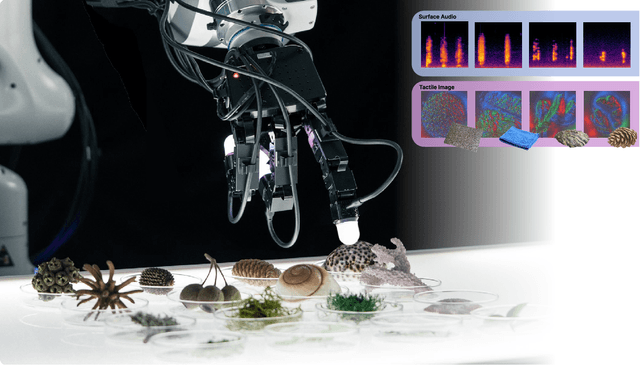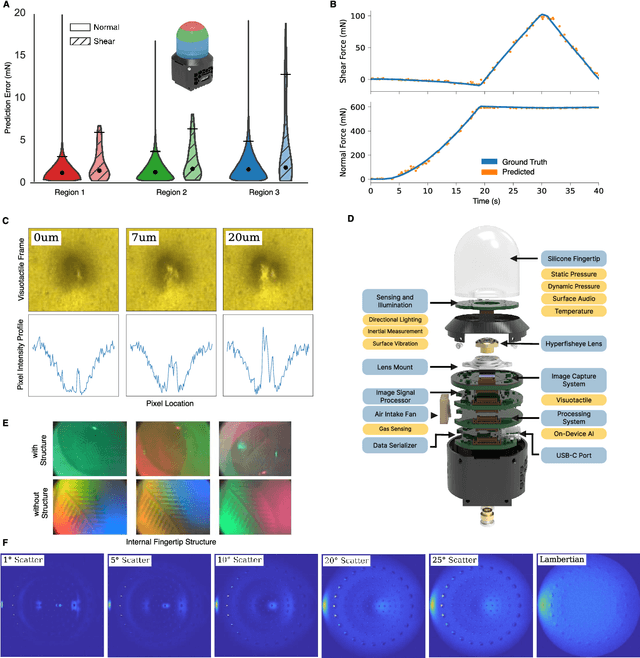Yitian Ding
Digitizing Touch with an Artificial Multimodal Fingertip
Nov 04, 2024



Abstract:Touch is a crucial sensing modality that provides rich information about object properties and interactions with the physical environment. Humans and robots both benefit from using touch to perceive and interact with the surrounding environment (Johansson and Flanagan, 2009; Li et al., 2020; Calandra et al., 2017). However, no existing systems provide rich, multi-modal digital touch-sensing capabilities through a hemispherical compliant embodiment. Here, we describe several conceptual and technological innovations to improve the digitization of touch. These advances are embodied in an artificial finger-shaped sensor with advanced sensing capabilities. Significantly, this fingertip contains high-resolution sensors (~8.3 million taxels) that respond to omnidirectional touch, capture multi-modal signals, and use on-device artificial intelligence to process the data in real time. Evaluations show that the artificial fingertip can resolve spatial features as small as 7 um, sense normal and shear forces with a resolution of 1.01 mN and 1.27 mN, respectively, perceive vibrations up to 10 kHz, sense heat, and even sense odor. Furthermore, it embeds an on-device AI neural network accelerator that acts as a peripheral nervous system on a robot and mimics the reflex arc found in humans. These results demonstrate the possibility of digitizing touch with superhuman performance. The implications are profound, and we anticipate potential applications in robotics (industrial, medical, agricultural, and consumer-level), virtual reality and telepresence, prosthetics, and e-commerce. Toward digitizing touch at scale, we open-source a modular platform to facilitate future research on the nature of touch.
Bias and Toxicity in Role-Play Reasoning
Sep 21, 2024



Abstract:Role-play in the Large Language Model (LLM) is a crucial technique that enables models to adopt specific perspectives, enhancing their ability to generate contextually relevant and accurate responses. By simulating different roles, theis approach improves reasoning capabilities across various NLP benchmarks, making the model's output more aligned with diverse scenarios. However, in this work, we demonstrate that role-play also carries potential risks. We systematically evaluate the impact of role-play by asking the language model to adopt different roles and testing it on multiple benchmarks that contain stereotypical and harmful questions. Despite the significant fluctuations in the benchmark results in different experiments, we find that applying role-play often increases the overall likelihood of generating stereotypical and harmful outputs.
Gender Bias in Large Language Models across Multiple Languages
Mar 01, 2024



Abstract:With the growing deployment of large language models (LLMs) across various applications, assessing the influence of gender biases embedded in LLMs becomes crucial. The topic of gender bias within the realm of natural language processing (NLP) has gained considerable focus, particularly in the context of English. Nonetheless, the investigation of gender bias in languages other than English is still relatively under-explored and insufficiently analyzed. In this work, We examine gender bias in LLMs-generated outputs for different languages. We use three measurements: 1) gender bias in selecting descriptive words given the gender-related context. 2) gender bias in selecting gender-related pronouns (she/he) given the descriptive words. 3) gender bias in the topics of LLM-generated dialogues. We investigate the outputs of the GPT series of LLMs in various languages using our three measurement methods. Our findings revealed significant gender biases across all the languages we examined.
 Add to Chrome
Add to Chrome Add to Firefox
Add to Firefox Add to Edge
Add to Edge